Somnath, Veraval, Porbandar, Jamnagar, Rajkot & Bhuj Fri 29 Jan – Sun 7 Feb 2010
We drew into Somnath around the middle of the afternoon. Somnath is a fairly understated little town with its main (only?) drawcard tourism - wise being its sea set temple. This also accounted for the heavy police presence everywhere - the temple is a focus of a great deal of security, maybe because historically it's always been under attack. Dating back centuries the temple was visited by an Arabian traveller in 1024. He waxed so lyrical about its grandeur - 500 dancing girls, 300 musicians and 300 barbers!- that based on his description Mahmud of Ghazhi from Afghan - a notorious looter -came south to completely strip the temple of its wealth and destroy it. This began a pattern of Muslim destruction and Hindu rebuilding which went on for centuries. After the 1706 destruction they finally gave up - until the last and enduring rebuild in 1950 financed by a Mr. SV Patel whose statue adorns the square to the front of it. As mentioned there was a fair bit of security around the temple - no phones or camera allowed and a full on body search on the way in - so we've got no real photos of the inside but it was built to traditional designs and was pretty impressive. An indicator out the back pointed directly to the south pole on a line which divided the Indian Ocean from the Arabian Sea making it an auspicious site for a temple.
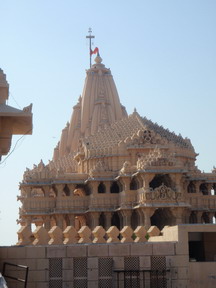
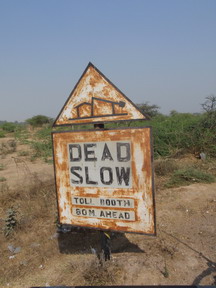
East of Somnath at the next coastal bay was Veraval a little town with the distinction of having the largest fishing port in Asia - over 4,000 boats work from here. There was great deal of bustle with teams of men repairing/building wooden boats everywhere we looked and a (strong!) fishy odour prevailing. We had decided to try and find a place to camp here so as not to drive on in the dark.
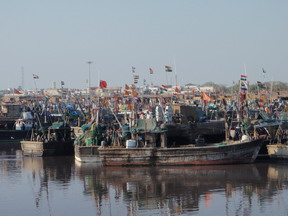

It had been so relaxing at Diu - being welcome to camp everywhere - so it was hard to go back to having to scout around for a camp spot. As recounted elsewhere this can be a bit tricky on occasions. We headed out to near the lighthouse as it looked to be the quietest part of town and had a bit of a wonder on the seafront and spoke to a few very friendly locals. We were initially really pleased when we spied the (government run) Toran Tourist Bungalows nearby as it looked to be a good spot for camping with a spacious parking area. The proprietor did say we could camp -for a fee of 300 rupees a night - far more than we're used to paying and a bit rich seeing as the rooms were only marginally more expensive.
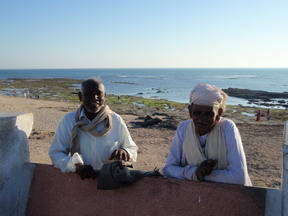

We decided to press on and try our luck elsewhere so we drove on a bit out of town to the Hotel Park. This was a very good move indeed - the proprietor Mr. Abdul Wadud Banatwala was extremely welcoming and invited us to park in the hotel's parking area free of charge. Abdul was an interesting character who is very active in both environmental and social issues. He is an Executive Director of the environmental organization "Earth Matters" and was heavily involved in the making of the documentary "Shores of Silence" which highlighted the plight of the whale shark- a gentle creature being culled by Indian fishermen. As a direct result of this film the existing law was changed to protect these creatures and they are now thankfully increasing in number. As a result of this Abdul was awarded an Ecco Warrior award by the Vice President of India in 2008.
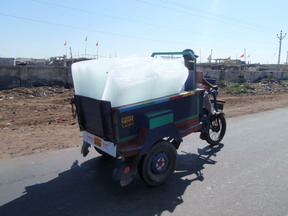

Abdul has also been very active in helping the local young girls. Through his foundation named 'Karim's Dream" after his father he has helped the local poor girls develop their traditional skills in embroidery into businesses thus escaping the cycle of poverty which has trapped a lot of these people for generations. These girls have been condemned to a life as rural labourers but through the training of the organization they are given the confidence and abilities to use their existing skills to make money by founding businesses. To find out more about these concerns contact Abdul directly on 09898042056 or via email abdulwadud@radiffmail.com
Abdul certainly made us very welcome and treated us to a 5 course meal in his restaurant at which we were joined by his 89 year old mother. Thanks Abdul - we'd certainly recommend the Hotel Park as a place to stay and the food (non- veg for a change!) was delicious. The hotel's website for bookings or further information is www.hotelpark.in
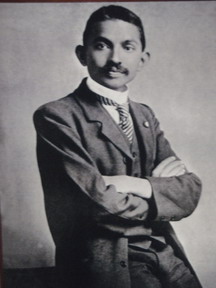
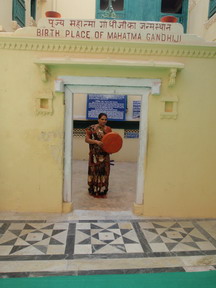
Next morning we headed on up the coast where we had a bit of a mishap. This is the first time this has happened which is incredible given the driving conditions in India but we hit a goat. A herder was moving his goats across the road and they had reached the other side - when one changed its mind and bolted back in front of us giving us no choice but to hit it as we did an emergency stop. As I said this is the first time this has happened though we've had some close calls and thankfully it wasn't a sacred cow as these have right of way in India and to kill one on the roads is a prisonable offence. Sacred or not they mill about on the roads in a suicidal manner and are part of the reason we avoid driving at night.
Anyway we did the right thing and pulled up though we have been told to keep driving in this event but we judged correctly that this wasn't a hostile area. With the help of some good samaritans who came to our aid as translators we negotiated an acceptable sum in compensation of 200 rupees - or $5 Aus. It wasn't our fault but what do you do - the goat looked more shocked than anything hopefully he recovered!
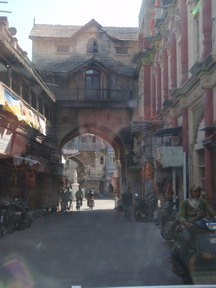

We pulled up mid morning at the port town of Porbandar. This little beachside town is (slightly) on the tourist map only as it is the birthplace of Mahatma Gandhi. He only actually lived here until the age of 6 when he moved to Rajkot but at his home and the Kirti Mandi memorial next door there is an interesting display on his life. Much of this we've seen before being seasoned attendees at various Gandhi tourist spots but it was interesting to see the spot (marked with a flower swastika the Hindu sign of peace) on the floor where the great man was born. No pictures allowed inside. The 220 year old house is a warren of 20 plus rooms where 3 generations of the Gandhi family lived a fairly affluent life befitting Mr. Gandhi senior's role as a senior financial clerk for the government.
Next stop was another pilgrimage town of Dwarka. This is a remote spot at the end of a peninsular and is allegedly where Krishna once lived and fought various battles. There have been various excavations which have revealed 5 earlier cities off the coast covered now by the encroaching sea. Again we tried to find a camp spot and again we chose a quiet area near the lighthouse. Again nil points for helpfulness for the government run hotel here. The Toran Guest House whilst having a huge car park and also housing the tourist information office wouldn't let us camp. There was little English spoken (and unhelpfully for a tourist office not even a map of the town) but we soon got the message we were far from welcome.
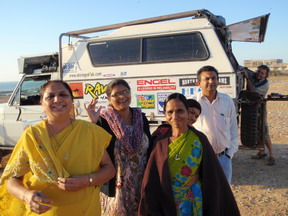

So we drove to the nearby headland next to the lighthouse where some friendly ladies came out of what we thought was a semi -derelict house to talk to us. We asked if we could camp there (thinking it was their home) and were whisked into what turned out to be a government office the HQ of the Child Development Board. There was full on board meeting in progress and we were taken in to meet the high ups who gave us tea and took pictures of us with their mobiles but didn't really get what we were asking vis a vie camping and kept suggesting hotels to us.
We left after watching the sunset but snuck back after dark and camped there quite happily. The next morning a local policemen arrived (we're not sure if he'd been called to suss us out or just turned up) but he was very friendly and mainly interested in telling us about his international travels as a drummer with a Gujarati Cultural group- so no problems!


Prior to this that evening we had had a look around the Dwarkanath Temple dedicated to Krishna. Again no pictures inside. It was full moon which is a big deal for Hindus and there were bands and drummers outside and a real carnival atmosphere on the streets - great fun.
At dinner we were shocked (we are after all in dry Gujarat) to see a selection of beers - until we looked closer and saw they were all copies of originals and completely non alcoholic - they were also very expensive so we didn't bother to try!! The names were excellent eg) rather than King Fisher King Fighter - inadvisable name for a beer!
Incidentally in our interactions with local people we have started to feel a bit awkward admitting to being Australians as there has been so much press coverage about the violence directed against Indian students. We have taken to saying we're English (well we both have the passport) and other Aussies we've met have been posing as Kiwis. We've never felt threatened it's more to avoid having the inevitable conversation about it all - especially as we left Australia over 2 years ago and really have no idea. I can't believe Australia has changed so much from the tolerant country we left and imagine it's the good old media talking it up but it is a shame to have to face this issue on a daily basis.


After another look around town (and a delay whilst we made a few phones calls sorting out a defunct boiler in our house in Narrabeen - thanks so much Tony for your help!) we headed next afternoon towards the city of Jamnagar. After having the issues detailed above finding a camp spot we were a bit concerned to be hitting the city as darkness fell. A few kms outside the city centre we pulled up at the quite grand Hotel Vishal International. Andrew suggested asking if we could camp there to avoid hitting the city but as I said it was quite a flash hotel so we weren't very hopeful. "Of course you can" said the very helpful manager "no charge whatsoever" - and we pulled up out the back next to the "Windsor Club" gym and the beautifully manicured lawn. You really can't pick it - some of the semi empty grotty government guest houses you'd think would be glad of a few extra customers in their restaurant treat you with distain and a really nice international hotel welcomes you in. We were made so comfortable here (and the restaurant's food was so good) we actually stuck around an extra day updating the website. Definitely recommended the hotel's website is www.hotelvishal.com


Poor Jamnagar everyone we asked told us there wasn't much to see- but whilst it's not really a "must see" tourist -wise it was a nice quiet little city and very friendly. The town is built around the Ranmal Lake in the centre of which stands a small palace occupied by the Maharaja of Nawanagar prior to independence. Like much of the city's old buildings the palace was a bit decrepit and seemed to be being held up by bamboo scaffolding, but it now houses a small museum which was quite interesting.
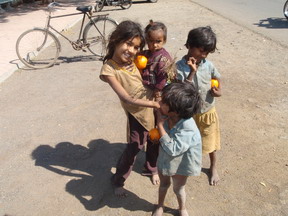

The city constantly interwove the new and the old - petrol stations next to ancient monuments - effectively and was pretty atmospheric. As ever there seemed a fair bit of poverty and we stocked up on fruit at the markets of the central Chandi Bazaar to give out to the various kids who approached us. One old shop specialized in making bangles. The proprietor's great grandfather had made them out of elephant tusks and there were some great old photos of these days - but now they're all made of plastic. More environmentally friendly but less glamorous!
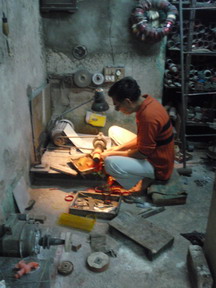
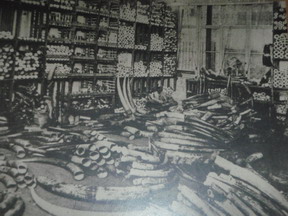
We wandered around the old city which seemed to shut down in the middle of the day to miss the heat even though it is now winter. In the centre are 4 Jain temples - all of them exploding with beautiful murals mirrored domes and elaborate chandeliers - which unfortunately you'll have to take our word for as no cameras allowed inside! We got a few shots of the marble exterior though.
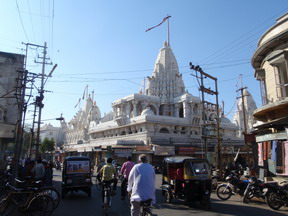
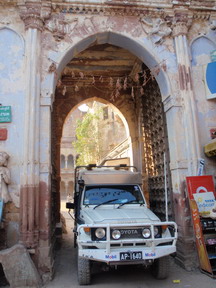
Finally as dusk fell we went to see the lakeside Bala Hanuman Temple. This temple is famous (it stars in that Indian favourite the Guinness Book of Records)- as having hosted continuous 24 hour chanting - "Shri Ram Jai Ram Jai Jai Ram" since 1 August 1964. The original guru who founded it - Shri Prambhikshuji Maharaj died in April 1970 but - despite flood cyclone and war - the chanting has continued to this day without a break with (obviously!) interchanging groups of chanters! There was an enthusiastic crowd when we visited from toddlers to old people and they certainly seemed to be getting something out of it.
 The next morning we went to leave Jamnagar and stopped first at the government water tower to fill our water tank. The guys were very friendly and insisted on taking us to the top of the water tank to see the outstanding view of the city. This was a bit scary for me involving climbing up little ladders and it felt very high at the top!
The next morning we went to leave Jamnagar and stopped first at the government water tower to fill our water tank. The guys were very friendly and insisted on taking us to the top of the water tank to see the outstanding view of the city. This was a bit scary for me involving climbing up little ladders and it felt very high at the top!
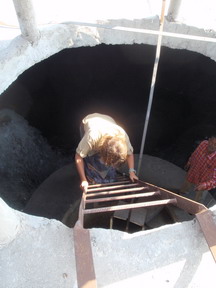
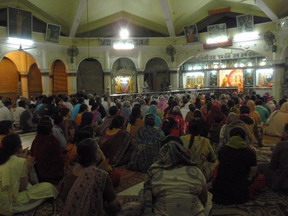
Interestingly there was a plaque at the entrance to the water plant thanking the Polish Government for funding it. Apparently in WWII the area had hosted over 5000 Polish refugee orphans. Jumping about a bit in my narrative when in Rajkot we visited the exclusive Rajkumar College (of which more later) there was a picture of the Maharaja an old boy of the school who through the years of the war welcomed these children and treated them very kindly. When they returned to Poland after the war they remembered this and apparently to this day his picture graces many restaurants and businesses and streets are named in his honour in parts of Poland. The funding of the water plants by Poland was another attempt to thank India for this assistance largely from this one man - whose name sadly we didn't get.
So with a full water tank we drove on towards Rajkot the capital city of the former princely state of Saraushtra and now part of Gujarat. Again we had a few issues finding a camp spot. As Rajkot is a big city we had expected this so we went first to the tourist information. They were friendly (though with little English) but not much help - again no maps of the city - but they directed us to one hotel who directed us to another who directed us another etc etc Whilst some of them were really nice and gave us tea they wouldn't let us park - the official explanation being that they felt responsible for us and concerned for our safety. This doesn't ring true when you think that this refusal put us in the position of having to camp outside the hotel walls - surely less safe. Anyway as darkness fell and we were getting very tired we pulled up a few miles out of town. There were some road workers and their families camping nearby. These people are usually economic migrants following the work and camping until a project is completed. We mimed what we wanted and they agreed that we could stay and we spent a hassle free night. The next day when we got up many more workers had arrived and they were hard at it mixing cement and building. There were 10 or so small kids hanging around playing - no school for them, They were really nice welcoming people and we planned to go back for another night but when, for reasons to follow, we didn't do this we went out specially with a bag of groceries for them to say thank you for letting us stay.
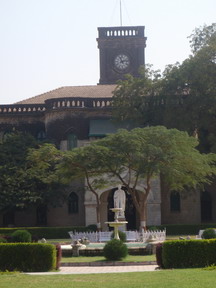
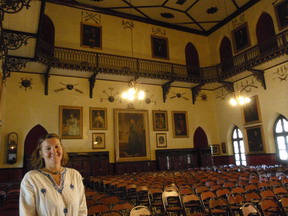
Anyway after a good night's sleep off we headed to see Rajkot. It is a go ahead sort of city - a lot of new building going on - and as we've seen before the 2 different Indias colliding everywhere as glossy new shopping malls stand adjacent to stalls with traditionally turbaned farmers selling their veggies and meandering livestock.
Our first stop was the very exclusive Rajkumar College as mentioned above. The fact that we visited here was all a bit of a misunderstanding. I had it in my head that Gandhi actually went to school here and that for this reason part of the school was open as a museum. We fronted up at the offices of the prestigious school buildings somewhat to the confusion of the office staff!! We were about to slink away when a Mr. Sunil K Lal - a teacher, house master and cricket coach -came to greet us wreathed in smiles and showed us around. The school was built in the early 19th century by the British for the children of nobility (Rajkumar means Prince). In the first year there were only 5 pupils but they each had a personal staff of 20 odd servants which swelled numbers a bit! The grounds were modeled on Cambridge and were beautiful all arches and manicured lawns with a gym, swimming pool, stables and (of course!) cricket oval. There was an impressive list of ex-pupils who had played cricket both for England (before independence) and then India. This was the somewhat tenuous link with Gandhi - he had attended a nearby school which had no sporting facilities so he had practised cricket here and his father had been the school's accountant for a short period.
Mr. Lal and the principal we met briefly were both charming and the school had a happy feel to it. There were a visiting posse of students on an exchange from a very grand school in Europe and the school has a lot of links with overseas school including a few in Australia - through the round square association.
There was an impressive hall - very English- with portraits of British royalty and Principals past and present and various renowned old boys - including the Maharaja mentioned above who helped the Polish refugees. It was a really interesting experience - and a bit of a sharp contrast between the privileged youths here compared with our young education-less building site gang from that morning!
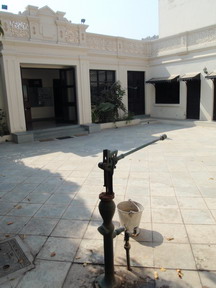
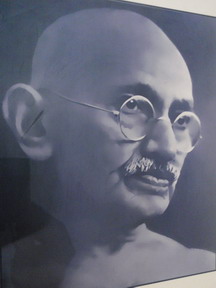
Next we went to Gandhi's house - Kaba Gandhi No Delo - this was buried in the depths of the old city and we had a bit of a struggle finding it. After abandoning the car and taking a rickshaw we got there. It was a large building with again an interesting display re: the great man - interspersed with quotes from the many who knew/were influenced by him from Martin Luther King, to Einstein and even Charlie Chaplin!

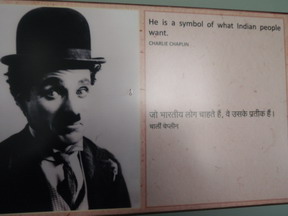
We then had a look around the lovely BAPS Hindu temple. This is a (wealthy!) sub-sect of Hinduism which apparently exists around the world and the temple had just been completed. It was very stylish with detailed carvings constructed out of pink sandstone.

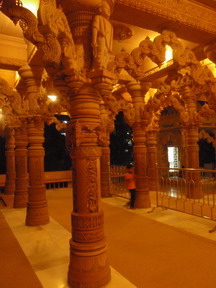
We had been having issues with our car battery which we had bought back in Pondicherry. Whilst still functioning ok it was leaking so we had resolved to get it replaced whilst it was still under warranty. We had done some research and tracked down the nearest Bosch store here - which turned out to be very fortuitous because there we met Hans Mehta a Rajkot native (he attended the Rajkumar College mentioned above) and the proprietor of the Bharat Petroleum's Service Centre. He not only changed our battery he invited us to stay at his lovely home (I think he was a bit horrified re: our sleeping arrangements of the previous night!) where we met his wife Roopa and 2 children and all the neighbours from his apartment block who were really interested in our trip.
Whilst changing the battery out on the street we'd generated the usual crowd and once again we got some media attention when the local rag did a story with pictures on us. Thanks so much to Hans and Roopa for having us to stay - and particular thanks to Roopa who prepared a special Gujarati breakfast the next day which was absolutely delicious.
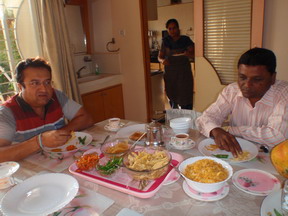
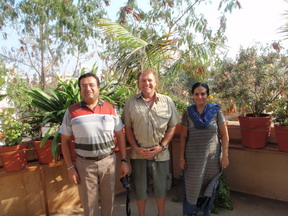
Hans and Roopa invited us to stay on and we could have got very comfortable in their lovely apartment but with an eye to our ever shrinking visa we really felt we had to keep moving. So we drove West to the province of Kutch.
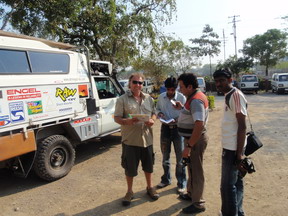

Kutch is a wild desolate area flat and dry and somewhat inhospitable dotted with villages many of which specialize in diverse handicrafts. It is in fact a seasonal island edged by the sea of the Gulf of Kutch which looks across to Pakistan and the deserts of the Great and Little Ranns. During the dry season these Ranns are vast expanses of hard dry mud and during the monsoon they are flooded first by seawater and then by fresh. The salt makes the area very barren with the only growth being coarse grass which feeds the area's diverse wildlife. The Indus river once flowed through Kutch - its route having settlements of a 5,000 year old civilization which was in many ways very ahead of its time such as having good drainage and water storage systems - until the 1819 earthquake altered the river's course and left the whole area as a salt desert.
An even more massive earthquake followed in January 2001. This earthquake which killed over 30,000 people completely ruined a lot of the area's heritage razing some villages completely. Although the effects of this damage continue to be felt the people here are remarkably resilient and seem to have bounced back amazingly well.
First stop was Bhuj the capital of Kutch. As we drove in we saw a lot of salt which is the major product of this region (we later found that this salt is edible as opposed to the inedible stuff from the Ranns which is only used for industrial purposes ) and numerous wind turbine farms as production of this type of energy is big in Kutch there being a fair amount of wind all year round.


Bhuj was really hit by the 2001 earthquake and the process of rebuilding has been very slow and a lot of the buildings still show very bad damage. As ever when we hit town our first job was to find a camp spot. A lot of the hotels are sadly out of business. The old government hotel perched on a hill is now deserted - making it a great quiet camp spot but sadly the resident security guard wasn't having that. As we scouted around for a camp spot various kind people offered us places to camp at their homes and were generally hugely welcoming. We managed to find a spot outside Hill Gardens - a sort of fun park - the owner was very happy that we stay and there was a resident security guide who kept an eye on us so we were very safe.
The next morning as we got up several coachloads of tourists turned up - and ignoring the fun park came to look at us- in particular Andrew wrestling with our shower tent! Everyone was very friendly.
We head next to see the villages of Kutch and - due maybe to the proximity to the Pakistan border- you need a police permit for this so this was our first stop. We had to fill in a form giving details of places to be visited along with copies of our passports and visas - they're very much used to the process and it was accomplished quite swiftly. As mentioned the people here are very friendly but as a rule much less English is spoken than in other areas we've visited. The local language Kutchi has no written form so most people also speak Gujarati and sometimes Hindi - but little English. It didn't really cause any problems though - we're quite adept nowadays at miming what we want!!

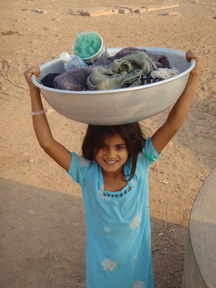
Anyway with our permits firmly in hand we set off to have a look around Bhuj. The centre of town has an attractive lake -Hamirsar Kund- and there was plenty of activity there with ladies doing their washing. There were also numerous bazaars and shopping areas but we thought we'd save this and look at the crafts when we visited the villages so we set off to see the museum and palaces.

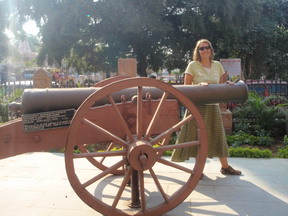
The Kutch Museum - Gujarat's oldest dating from 1877 - had a lot of interesting information on the various native people of the area & their crafts as well as many ancient artifacts.

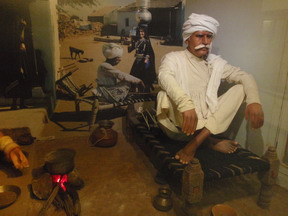
Interesting to us was the cannon outside which was actually gifted to one of the local Maharajas in the 19th century by our Mysore friend Tippu Sultan in exchange for some locally bred horses. Kutch horses are/were very rated hence the Kutch coat of arms with 2 horses on it.
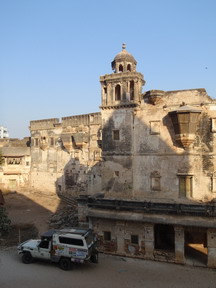
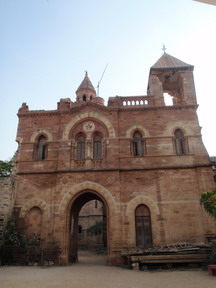
Next we took in the Aina Mahal a lovely palace built in 1752 which has a very European flavour. This palace was the site of the local tourist information office run by Mr. PJ Jethi who has also written an excellent guide book about the area. He really was one of the best informed passionate guides we'd met and gave us a wealth of information so if you're visiting the area it's definitely worth seeing him in the early stages of your trip.

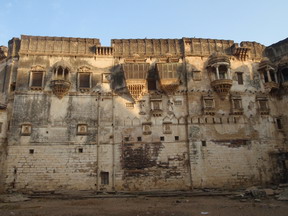
Though the Aina Mahal lost its top floor in the earthquake much of it remained intact and there were some interesting objects including a 19th century 15.2 metre painted scroll showing a Kutch procession, some detailed gold and silver work and the palace's elaborately mirrored interior.
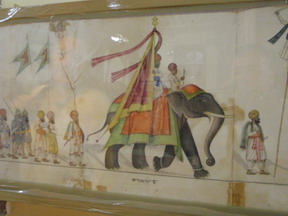
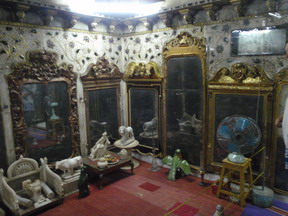
It had certainly fared better than the next door Durbar Gandhi the oldest palace which had largely collapsed leaving only some elaborate carvings showing. Similarly the nearby Prag Mahal was in a Miss Havesham style state of decay.
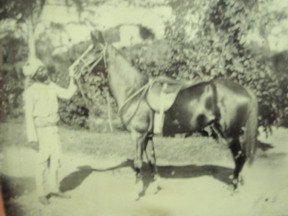
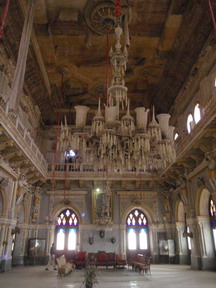
The Maharajas were big hunters and all the palaces are adorned with stuffed tigers/lions but here they were all moth eaten and falling apart - particularly a really battered looking hippopotamus shot on a trip to Africa with all its molars hanging out! The main hall was full of pigeons and pretty decrepit which was sad. In its glory days it was used in various Bollywood movies but would be good only for horror films now. The present Maharaja apparently lives in Mumbai and doesn't seem to be doing much to do it up. I guess it's a huge undertaking.
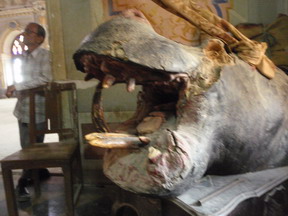

Final palace on our tour was the Sarad Bagh Palace. The Maharaja still lives here - we met him - and it was a graceful building built in the Italian style in 1867 in a beautiful garden - though parts of the building had been destroyed the remaining core was in good condition.

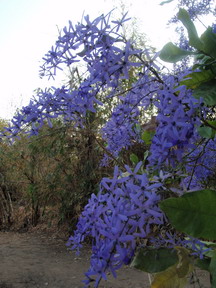
There were some gorgeous flowers around and we took a wonder despite the fact that one of the stuffed animals on display - a large leopard - had actually been shot in the garden! Luckily for us (but sadly I guess) there are none left now.

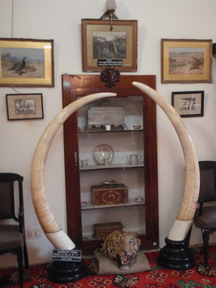
Next we had a look at a temple construction going on again a new building being constructed by the wealthy BAPS community mentioned above. This looks like a huge project and it was really interesting to see it as a work in progress. No one minded us walking around - the site is also a big camp site for the workers with all the kids playing as their parents work.
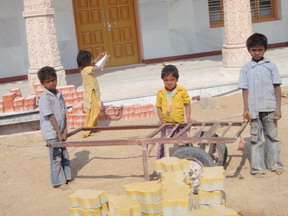
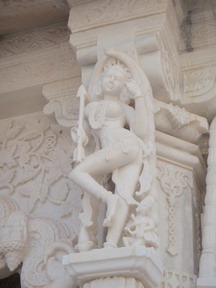
It will be truly beautiful and as we have with many temples maybe in 100s of years people will try and imagine it being built which we felt privileged to witness.
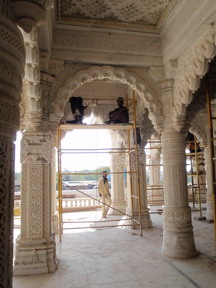

The workers were friendly and even invited us up the rickety bamboo ladders to see the roof carvings - though we declined on safety grounds!

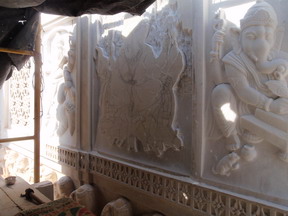
There was as ever a bit of poverty around though in view of the hardships suffered here not as bad as you might think. The little girl in our picture and her handicapped companion- friend/brother/father?? - had various begging areas and we kept seeing them around the city. We gave them some biscuits and fruit - which we buy especially for this purpose - and they seemed happy enough.

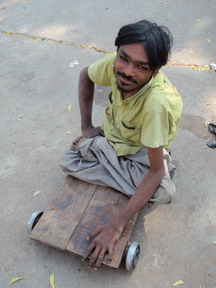
As we were heading off that evening we had to do a tyre rotation before we hit the rougher roads. We'd had a tyre blow out a few days back and as we move slowly towards Delhi to pick up our new Maxxis tyres we are starting to run on empty tyre -wise so we needed to move the tyres around to ensure that they wore evenly. We went to a roadside stop and found plenty of helpers (and not a few on lookers) to assist. They wanted their picture on the web so there you go guys thanks for your help! The nice old man with his granddaughter looked really aboriginal I thought, which supports the theory that the Aussie aboriginals are originally from the same gene pool as some of the Indians.
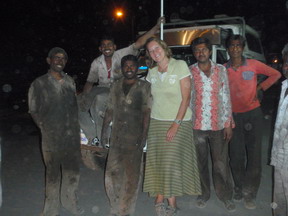

That evening we had dinner at the swanky Prince Hotel where we had an excellent Gujarati thali a gorgeous blend of local vegetarian tastes served alongside local butter milk - really good and served by teams of waiters in local costume.

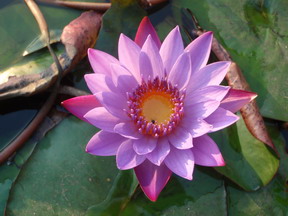
We spoke to the manager and (as we imagine have a lot of locals) he had an amazing tale of the earthquake. He awoke having worked all night to an incredible noise and dressed and left his house - he got 2 steps away from it when it totally collapsed missing him by feet. He said the area was in chaos for ages with the hotel providing meals for the huge number of homeless people whilst the search for bodies went on for weeks. Whilst we were there a small (2 on the Richter scale) earthquake caused panic at a local village. Clearly the tectonic plate in this area remains very unstable - which is a bit of a scary thought.
Next morning on Sunday 7 February- after stocking up on fuel and water - we drove on to begin our tour of Kutch heading first to the coastal town of Mandvi 60km to the South, a big centre for traditional wooden ship building and thus of huge interest to Andrew and the site of many beautiful beaches - of equally large interest to me!
